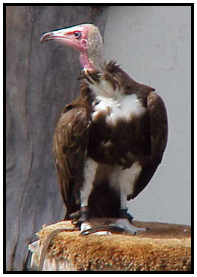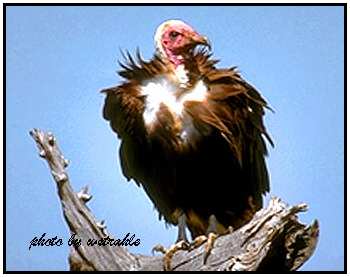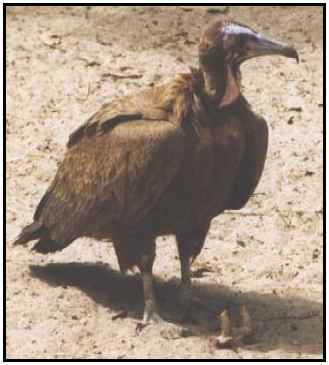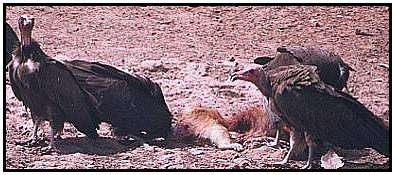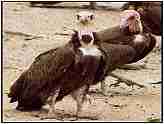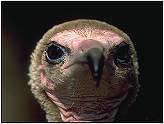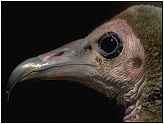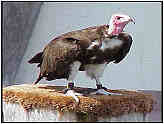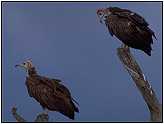HoodedOrder: Falconiformes. Family: Accipitridae. (Old World vulture). Scientific Name: Necrosyrtes monachus. Common Names: Hooded Vulture. Conservation Status: Common. Rescue & Recovery: None. The African villagers recognise this bird as doing a necessary job and do not harm or hunt it. In fact, it is so comfortable around humans that the Hooded Vulture is frequently to be seen hopping happily in and out of huts while the human inhabitants walk around it. Of all the Old World vultures the Hooded Vulture has best adapted to live alongside man.
Hooded Vulture (Photograph Courtesy of Sheldon Glucksman (Copyright ©2000)Geographical Range: From southern Egypt to eastern Africa where it is one of the commonest vultures. Not found in the Congo. Habitat: The only species which will venture into wet forest areas. Is often to be found near village markets or rubbish dumps, and in forest country with a high rainfall. Rarely seen on the savannah.
Hooded Vulture (Photograph Courtesy of Bill Strahle (Copyright ©2000)Physical Characteristics: This is the smallest vulture, being only slightly larger than a crow. The bare skin of the neck and face become dark pink as the blood vessels dilate. This is somewhat similar to human blushing and occurs during times when the bird is feeling aggressive or excited. It is purely involuntary and may act as a signal to other Hooded Vultures as to how various birds are feeling. This is a mainly brown bird, especially when it comes to juveniles, though in adults the brown colouration is relieved somewhat by patches of white. The bill on this vulture is particularly long and narrow, giving an easy way to identify it from other species. The bird gets its common name from the wool-like down which covers the lower throat and rear of the neck which resembles a hood. Adults are silent, but chicks squeal to the adults who are feeding them.
Hooded Vulture (Photograph Courtesy of Cliff Buckton (Copyright ©2000)Food: The Hooded Vulture is generally the first to move into a carcass, but once the more aggressive species arrive it is forced to wait on the sidelines until they have eaten their fill. It will then return to pick over what little remains. That it arrives first is solely due to its compact size. Vultures need thermals to gain altitude and so rise later in the morning than other birds; the smaller the vulture, the earlier it can rise and start scavenging. Once the sun is fully up the Lappet-faced and the African White-backed take over at which point the Hooded Vulture becomes the loser. Perhaps for this reason, and the fact that its beak is not powerful enough to cut through the tough hide of a animal, the Hooded Vulture is much less dependent upon carrion than most other vulture species. It catches lizards, termites and any other small creatures, plus will pick up dead fish along seashores.
Hooded Vulture (Photograph Courtesy of Cliff Bucton (Copyright ©2000)Reproduction: Courtship displays are not very impressive, however on occasion the male makes swooping dives at his mate as she dances in circles on the ground, claws outstretched. The nest is built in a tree, usually a baobab, though these vultures will take advantage of any old suitable nest, simply repairing it with leaves and hair. The female lays one egg and the parents share in the incubation which takes 46 days. Young chicks are very frail and require close care. For this reason, the female is not easily disturbed from the nest. Once it reaches three months the chick starts to hop about and takes flight about two weeks later. After another month it is fully independent and leaves home. The parents will remain together and return each year to nest in the same spot. Thumbnails (Click For Full-Size Image):
|

